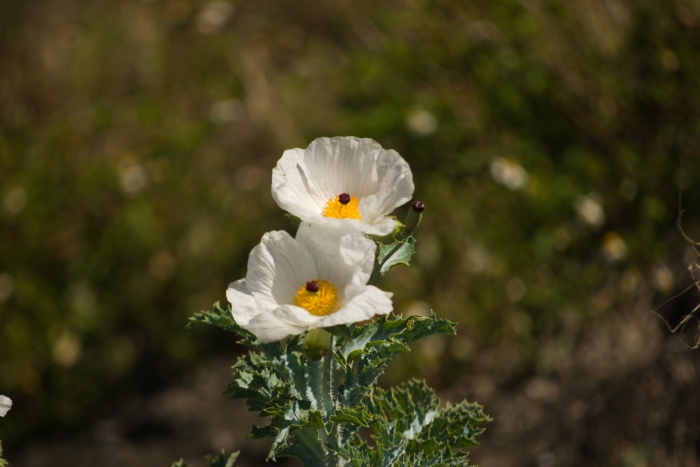Hawaiian Poppy
(Argemone glauca)
Hawaiian Poppy (Argemone glauca)
/
/

Kevin Faccenda
CC BY 4.0
Image By:
Kevin Faccenda
Recorded By:
Copyright:
CC BY 4.0
Copyright Notice:
Photo by: Kevin Faccenda | License Type: CC BY 4.0 | License URL: http://creativecommons.org/licenses/by/4.0/ | Rights Holder: Kevin Faccenda | Publisher: iNaturalist | Date Created: 2023-03-24T10:52:15-07:00 |


















Estimated Native Range
Summary
Argemone glauca, commonly known as Hawaiian poppy or pua kala, is a perennial herb native to the dry, rocky, and disturbed areas of the Hawaiian archipelago, from sea level up to 6,200 feet. It is particularly adapted to volcanic slopes and coastal habitats where it can tolerate harsh conditions. This species typically grows to a height of 1-3 feet (0.3-0.9 meters) and spreads about the same in width. The plant’s appearance is characterized by its spiny, bluish-green foliage and stems, which contribute to its glaucous appearance. The large, showy white flowers with bright yellow centers bloom from late spring to early fall, attracting pollinators and adding visual interest to the landscape.
Argemone glauca is valued for its drought tolerance and striking floral display, making it suitable for xeriscaping and rock gardens in warm climates. It requires minimal maintenance once established, thriving in full sun with very little water, and is best suited to well-drained, sandy or rocky soils. While not commonly used in cultivation, it can serve as an ornamental in themed gardens that mimic its native habitat. Gardeners should handle the plant with care due to its thorny nature and the toxic yellow latex it exudes when cut or damaged. There are no popular garden cultivars of this species, and it is not typically associated with significant disease problems. However, its toxic latex should be considered a potential issue, especially for those with pets or small children.CC BY-SA 4.0
Argemone glauca is valued for its drought tolerance and striking floral display, making it suitable for xeriscaping and rock gardens in warm climates. It requires minimal maintenance once established, thriving in full sun with very little water, and is best suited to well-drained, sandy or rocky soils. While not commonly used in cultivation, it can serve as an ornamental in themed gardens that mimic its native habitat. Gardeners should handle the plant with care due to its thorny nature and the toxic yellow latex it exudes when cut or damaged. There are no popular garden cultivars of this species, and it is not typically associated with significant disease problems. However, its toxic latex should be considered a potential issue, especially for those with pets or small children.CC BY-SA 4.0
Plant Description
- Plant Type: Herb
- Height: 1-3 feet
- Width: 1-2 feet
- Growth Rate: Moderate
- Flower Color: White, Yellow
- Flowering Season: Spring, Summer, Fall
- Leaf Retention: Deciduous
Growth Requirements
- Sun: Full Sun
- Water: Low
- Drainage: Fast
Common Uses
Deer Resistant, Drought Tolerant, Low Maintenance, Rock Garden
Natural Habitat
Dry, rocky, and disturbed areas, volcanic slopes, and coastal habitats of Hawaii
Other Names
Common Names: Prickly Poppy, Pua Kala, Hawaiian Prickly Poppy
Scientific Names: , Argemone glauca, Argemone alba subsp. glauca, Argemone alba subsp. glauca, Argemone alba var. glauca, Argemone alba var. glauca, Argemone glauca var. decipiens, Argemone glauca var. inermis,
GBIF Accepted Name: